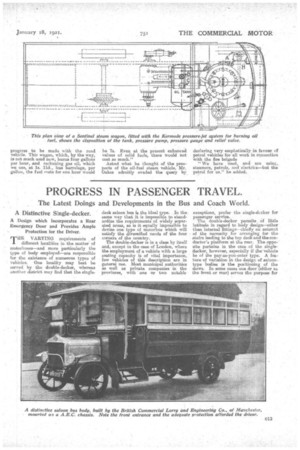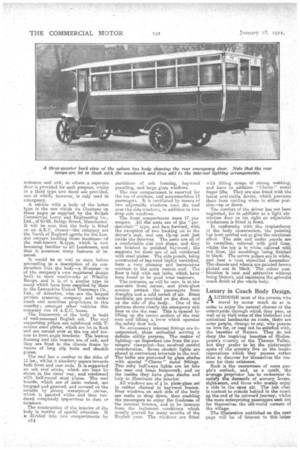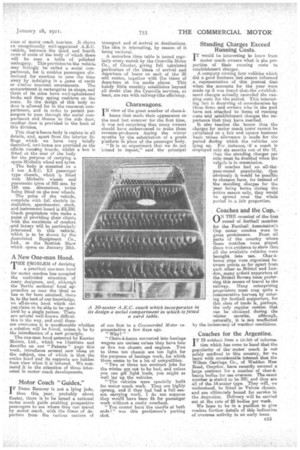PROGRESS IN PASSENGER TRAVEL.
Page 17

Page 18

Page 19

If you've noticed an error in this article please click here to report it so we can fix it.
The Latest Doings and Developments in the Bus and Coach World.
A Distinctive Single-decker.
A Design which Incorporates a Rear Emergency Door and Provides Ample Protection for the Driver.
THE VARYING requirements of different localities in the matter of motorbuses—and more particularly the type of body employed—are responsible for the existence of numerous types of vehicles. One locality may beet be served. by. the doubLa-decker, whereas another district may find that the single deck saloon bus is the ideal type. In the earns way that it is impossible to standardize the requirementsof widely separated areas, SO i8 it equally impossible to devise one type of motorbus which will satisfy the diversified needs of the four corners of the country.. The double-decker is in a class by itself and, except in the ease of London, where the employment of a vehicle with a large seating capacity is of vital importance, few vehicles of this description are in general use. Most municipal authorities as well as private companies in the provinces, with one or two notable
exceptions, prefer the single-decker for passenger service.
This double-decker permits of little latitude in regard to laody design—other than internal fittinge---chielly on account of the necessity for arranging for the stairs leading to the top dealt and the conductor's platform at the rear. The. opposite pertains in the case of the singledecker, however, especially if the-vehicie be of the pay-as-you-enter type. A lea. burg of variation in. the design of saloontype bodies is the positioning of the doors. In scene eases one door (either nr, the front or rear) serves the purpose for
entrance and exit, in others, a separate door is provided for each purpose, whilst in a third type. two doors are provided, one of which., however, is only used in emergency.
A vehicle with a body of the latter typo is the one which we illustrate on these pages as supplied by the British Commercial Lorry and Engineering Co., Ltd., of 60-68, Bridge Street, Manchester. It will be seen that the body is fitted on an A.E.C. chaesis—the company are the North of England agents for the London concern building these machines—of the well-known K-type, which is now becoming familiar to all Londoners, and that it possesses many features of interest.
It would be as well to state before proceeding to a description of its conetruction that the body—a 30-seater—is of the company's own registered design bent in their coachworks at Whalley Range, and it is of a similar type to many which have been supplied by them to the Lancashire United Trarreways Co. Ltd.; of Atherton, -wive are the largest private tramway company and rooter coach and motorbus proprietors in this counny ; amongst other vehicles this company run 14 A.E.C. buses.
The framework . of the body is built of well-seasoned English ash. The roof supporting pillars are reinforced with Tsection steel plates, which are let in flush and are burned over at the top and bottom to form angle beackete. The bottom framing and the bearers are of oak, and they are fixed to the chassis frame by means of long clip bolts and shackle plates.
The roof has a camber to the sides of 11 ins., whilst it alenderly tapers towards both front and rear ends. It is supported on ash roof sticks, which are bent by steam in the usual way, and reinforced with ball-round steel plates. The roof boards, which are of satin walnut, are tongued and grooved, and covered on the outside by strong waterproof canvas, which is painted white. and thus rendered cempletely impervious to dust. or moisture.
The construction of the interior of the body is worthy of special attention. It is divided into two compartments by c14 partitions of ash framing, baywoud panelling, and large glees windows.
The roar compartment is reserved for the use of smokers, and accommodates 13 passengers. It is ventilated by means of two Aim/table windows near the roof over the side windows, in addition to two drop side windows.
The front compartment seats 17 passengers. All the Beets are of the " gasden-chair" type, and face forward, with the exception of two backing on to the driver's seat, and one tip-up seat just inside the doorway. The seats are all of a comfortable size and shape, and they are finished in polished baywood; the sapports for them are of ash reinforced with steel plates. The side panels, being constructed of baywood highly varnished, form a very pia-.sing and harmonious contrast. to the satin walnut roof. The floor is laid with oak laths, which have been found to be good wear resisters.
The entrance, as will be seen, is at the near-side front corner, and plate-glass screens protect the passengers from draughts and a cold inrush of air. Breeds handrails., are provided on the door, and on the side of the body.. One of the pictures shows, clearly the emergency exit door at the the rear. 'Thi8 is opened by lifting up the centre section of the roar seat and lifting a lever which operates the safety door lock..
No a.nnecessary internal fittings are incorporated, those embodied serving a definite utility purpose. The matter of lighting—an unportiant one from the passengers' viewpoint—has received careful coneideratiosa. Seven electric lights are placed at convenient intervals in the roof. The bulbs are protected by glass shades with special "Clarno " metal fittings. Two ruby bull's-eye lights are let into the rear end brass framework, and on the insides they have glass shades and help to illuminate the interior.
All windows are of in. plate-glass.set in rubber channel in beyweocl frames. Four windows on each side of the body are made to drop down, thus enabling the messengers to enjoy the freshness of the summer breezes, and to be immune from the inclement conditions which usually prevail for many months of the English year. The windows are fitted with lifting straps of strong webbing, and have in addition "Clarno" metal finger Rte. They are also fitted with the latest anti-rattle device, which prevents them from rattling when in either position—up or down. 'The comfort of the driver has not been neglected, for in addition to a. light aiuminitun door on his right an adjustable windscreen is fitted in front.
In conformity -with the resplendency of the body construction, the painting has been earned out to give the maximum effect. The side arid under panels are in vermilion, relieved with gold lines, whilst the top is in white relieved with red lines, the mouldings being finished in Mack. The corner pillars are in white, and bear a neat stencilled decoration The chassis/ and wheels are painted beewn picked out in black. ' The colour coin
/ hination is neat end attractive without being blatant, and maintains the splendid coach finish of the whole body.
Luxury in Coach Body Design. Luxury in Coach Body Design. ALTHOUGH most of the persons who travel by motor coach do so in order to enjoy the natural charms of the countryside through which they pass, as well as to visit some of the historical and asthetical landmarks en route, there are some people, strange to gay, who possess no love for, or may not be satisfied with, the beauties of Nature. They do not deny the inspiring beauties of Shakespeare's ceuntry or the Thames Valley, but they prefer to let the picturesque spots of the country live on the innate reputations which they possess rather than to discover for themselves the -reasons for their existence.
Such is the narrowness of some people's outlook, and, as a result, the average proprietor has to endeavour to satisfy the demands of scenery lovers, sight-seers, and those who merely enjoy a ride in the open air. The last class is content to remain behind in the coach at the end of its outward journey, whilst the more enterprising passengers seek out for themselves the old-world corners of the village.
The illustration published on the next page will be of interest to this latter class of meter coach tourists. It shows an 'exceptionally well-appointed A.R.C. vehicle, "between the third and fourth rows of seaSks of the body of -which. there will be seen a table of polished mahogany. This provision on the vehicle may fittingly be called a social cornpartment, for it enables passengers disinclined for exertion to pass the time away by indulging in a game of cards
or similar innocent, amusements. The compartment is rectangular in shape, and three of its sides have well-upholstered backs and deep spring cushions on the seats. In the design of this body no door is allowed for in the rearmost compartment, and in order to permit passengers to pass through the Aocial compartment and thence to the side door, another door is provided in the back of this division.
This char-a-baneshody is replete in all details, and, apart from the interior fittings which we have very briefly described, tool-boxes are provided on the offside running boards, whilst a box is fitted at the rear of the body for the purpose of carrying a spare Michelin wheel and tyres. The body is mounted on a 3 ton A.R.C. YJ passenger type chassis, which is fitted. with Miohelin wheels and pneumatic tyres of 950 rim. by 153 ram. dimensions, twins being fitted on the rear wheels.
The price of the vehicle, complete with full electric installation, speedometer, clock, and instrument board is £2,350. *oath a proprietors who snake a point providing their clients with the maxiinum of comfort. and luxury will be partioularly -.interested in this vehicle, which is to he shown by the Associated Equipment Co., Ltd., at the Scottish Show which opens on January 28th.
A New One-man Hood.
THE kROBLE31 of devising a. practical one-mark hood for motor coaches has occupied the undivided attention of many designers, and, although the Bartle sectional hood approaches as near the ideal as has so far been attained, there is, to the best of our knowledge, no all-in-one hood which can yen claim to be able to be operated by a single person.There are several well-known difficulties in the way, and until these are overcome it is quetionable whether asolution will be found, unless it be by the introduction of a now principle. • The one-man .hood patented by Karrier Motors, Ltd., which we illustrate and describe on our "Patents" page this week, introdueee several new ideas on the subject, one of which is that the entire hood and its supports are hidden from view when it LS lowered. We commend it to the attention of those interested in motor coach developments.
Motor Coach "Guides."
I F Dame Rumour is not a lying jade, then this year, probably about Easter, there is to be issued a national motor coach -guide enabling prospective passengers to see where they can travel by motor coach, .with the times of dopsi-tune from the various centres of
transport and of arrival at destinations. The idea is inSeresting, by reason CI it being national.
A motorbue Jima table is issued regularly every month by the Crosville Motor Co., of Chester, giving full tabulated particulars of the times of arrival and departure . of buses on each of the 20 odd routes, together with the times of departure at via media places. This handy little monthly establishes beyond all doubt that the Crosville Services, at least, are run with railway-like efficiency.
Charawagons.
I N view of the great number of chars-abanes that made their appearance on the road last summer for the first time, it was not surprising that many owners should have endeavoured to make them revenue-producers during the winter months by the substitution -of a goods p'sitform in place of the passenger 'It is an experiment that we do oat intend to tepeat," said the principal
of orm firm to a aokornereeta Motor representative a few days ago.
" Why? "
" Chars-bsbancs converted into haulage wagons are uselesa unless they have four or five ton chassis and engines. Two to three ton chassis are too light for the purposes of haulage work, for which there seems to be a lot of competition.
"Two or three ton contract jobs for the winter are not to he had, and unless you can get light loads, you might as well lay up the vehicles.
"The vehicles were specially built for motor coach work They are highly sprung, and if they had had a full season carrying work, I do not suppose they wourd have been fit for passenger work without a costly overhaul.
"You cannot burn the candle at both enda!" WAS this gentleman's parting shot.
Standing Charges Exceed Running Costs.
I T Would be interesting to know from " motor coach owners what is tho proportion of their running costs to establishment charges. A company owning tour vehicles which did a good business last season informed representative of this journal that when the accounts for the year were made up it was found that, the establishment charges actually exceeded the running costs for the period. This interesting fact is deserving of coesideratien -by those firms and owners who-in the past have not. attached to items of running casts and establishment charges the im portance that they have merited. • It also teaches the lesson that the charges for motor coach tours cannot be calculated on a fair and -Square business basis unless allowance is made for the period during which the vehicles are lying up. For instance, 'if a coach is employed only six months out of the 12, then. the standing charges per mile must be doubled when the
vehicle is in commission.
If coaches had an all-the year-round popularity, then
obviously it would' be possible to cheapen Uses, for instead of the standing charges for the year being borne during the active season only, they would he Spread over the whole period in. a fair proportion.
Coaches and the Cup.
ON .111E oceasion of tare firs( round of football matches for the Football Associations Cup motor coaches wore in great prominence. From all parts of the country where these matches were played there wasevidence to show that all the available vehicles were -brought into nee. Char-as banes trips were organized between points so far apart from each other as-Bristol and London' many ardent supporters of the Bristol Rover% team preferring this means of travel to the railway. Many enterprising proprietors must reap quite a renamera.tive harvest by catering for football suPporters, for this class of trade is, perhaps, the only regular custom that can be obtained during the winter months, although, naturally, it is not unaffebted by -the inclemency of weather conditions.
, Coaches for the Argentine.
TT IS evident from a titbit informa1 tion which has come to band that the popularity of the motor poach is nob solely confined to this country, for we learn with considerable interest that the 171./iltoni Carriage Co:, of Wadslon New Road, Oroyclon, have recently secured a large contract for a number of char-abasics bodies for use overseas. The enact number is atated to be 300, and they are all of the. 14-seater type. They will,, we understand, be fitted to Vulcan chassis, and are ultimately bound for service in the Argentine. Delivery will be carried out at the rate of 25 bodies per week.
We hope to be in a position to give readers further details of this indication of overseas activity in an early. issue.
































